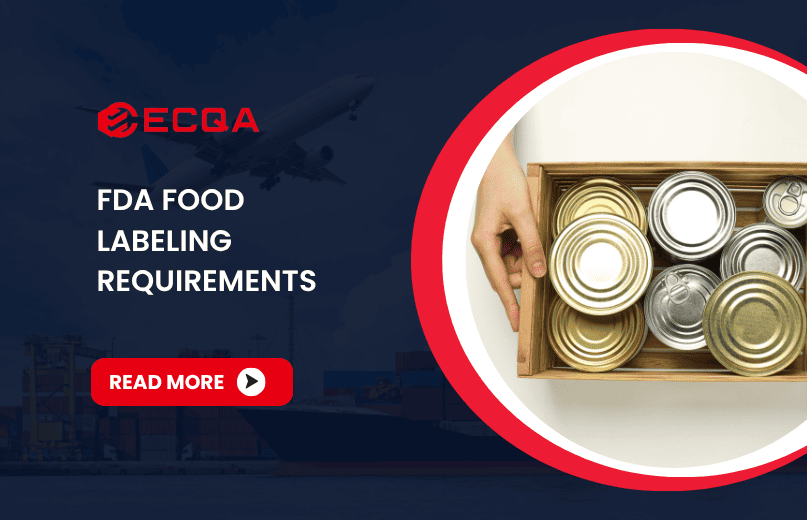
FDA Food Labeling Requirements
FDA regulated food products include most packaged foods sold in the United States, both domestically manufactured and imported. The Food and Drug Administration (FDA) is the primary regulatory authority responsible for setting labeling requirements under two key legislative frameworks:
These laws mandate that food labeling must be truthful, not misleading, and provide consumers with essential information regarding nutritional value, ingredients, and allergen content.

Importantly, not all food products fall under the FDA’s domain. The U.S. Department of Agriculture (USDA) regulates meat, poultry, and certain egg products. For all other foods,including snacks, beverages, baked goods, canned items, and dairy alternatives,the FDA maintains jurisdiction and enforces strict compliance through its Center for Food Safety and Applied Nutrition (CFSAN).
All packaged foods covered by the FDA must comply with these labeling regulations, regardless of whether they are manufactured in the United States or imported from overseas.
Mandatory Label Elements for FDA Compliance
Food labeling requirements focus heavily on two label areas:
- The Principal Display Panel (PDP) – the part of the label most likely to be seen by the consumer.
- The Information Panel – usually located immediately to the right of the PDP.
Required elements for FDA-compliant food labeling include:
Statement of Identity
The common or usual name of the food must appear prominently on the PDP.
Net Quantity of Contents
The package must declare the net weight or volume in both U.S. customary and metric units (e.g., “Net Wt 16 oz (454 g)”).
Nutrition Facts Panel
Unless exempt, a full nutrition panel must be provided. This includes calories, macronutrients, added sugars, and essential vitamins or minerals.
Ingredients List
All ingredients must be listed by descending order of weight. Any ingredients that are recognized allergens must be disclosed separately (see next section).
Name and Address of Manufacturer, Packer, or Distributor
This allows consumers to trace the product back to its origin. If the party named is not the manufacturer, the label must indicate their role.
Label Formatting Rules:
- Font size must be at least 1/16 inch in height based on lowercase “o”.
- Information must be in English, unless distributed exclusively in a non-English-speaking area.
- Bilingual labeling is permitted, provided that both languages include all required label elements.
Compliance with layout, type size, and label contrast requirements is not optional—errors in these areas can result in product detention or recall.
Nutrition Labeling and Nutrient Content Claims
FDA regulations clearly define when Nutrition Facts labeling is required. Most packaged foods must include it unless specifically exempt (e.g., very small businesses, foods sold for immediate consumption, or bulk containers for food service use).
Key Features of the FDA Nutrition Facts Panel:
- Serving size must reflect realistic consumption based on current data.
- Calories, total fat, saturated fat, trans fat, cholesterol, sodium, carbohydrates, dietary fiber, total sugars, added sugars, protein, and certain micronutrients (e.g., Vitamin D, Calcium, Iron, Potassium) are required.
Daily Value (%DV):
- Nutrients are listed with a % Daily Value, helping consumers assess the product’s nutritional impact based on a 2,000-calorie diet.
- Nutrient levels triggering claims (e.g., “high in fiber”) must meet specific thresholds established in FDA regulations.
Nutrient Content Claims:
These include expressions such as “low fat,” “reduced sodium,” or “sugar free.” The FDA has established clear criteria for these terms:
- “Low fat” means ≤3g per serving
- “Sugar free” means <0.5g sugars per serving
Unapproved or implied health claims (e.g., “supports heart health”) require careful substantiation and, in some cases, prior FDA approval. Using them without validation can result in enforcement action.
Allergen and Ingredient Disclosure Requirements
Under the Food Allergen Labeling and Consumer Protection Act (FALCPA), FDA mandates clear declaration of the Big 9 allergens, which are responsible for over 90% of allergic reactions in the U.S.:
- Milk
- Eggs
- Fish
- Crustacean shellfish
- Tree nuts
- Peanuts
- Wheat
- Soybeans
- Sesame
Labeling Format Requirements:
- Allergen statements must be clearly printed—typically immediately after the ingredient list—using the phrasing:
“Contains: Milk, Wheat, Soy.” - Alternatively, allergens can be disclosed in parentheses within the ingredient list:
“Whey (milk), lecithin (soy)” - Formatting must ensure visibility and legibility.
Additional Ingredient Considerations:
- Incidental additives (e.g., those present in trace amounts and not serving a functional role) may be exempt from listing.
- Processing aids, enzymes, and carry-over substances may not require disclosure unless they contain allergens.
- Country of Origin Labeling (COOL) is mandatory for certain food categories (e.g., fresh produce, seafood), especially when imported.
Allergen mislabeling remains one of the most common causes of FDA recalls. Manufacturers must implement strict control protocols, ingredient verification, and cross-contact prevention to stay compliant.
Failure to meet FDA food labeling requirements can result in serious consequences, including product recalls, import refusals, and damage to brand reputation.
To stay compliant, manufacturers must maintain accurate formulations, implement robust labeling controls, and regularly review packaging against current regulatory standards. Label integrity is essential not only for market access but also for consumer trust.

 Request Free Sample Report
Request Free Sample Report